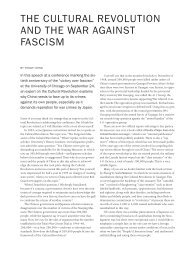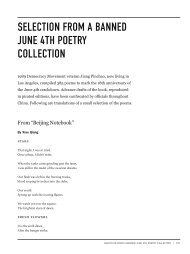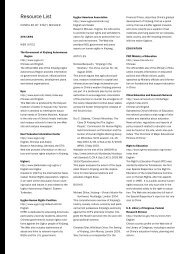STATE SECRETS: CHINA'S LEGAL LABYRINTH - HRIC
STATE SECRETS: CHINA'S LEGAL LABYRINTH - HRIC
STATE SECRETS: CHINA'S LEGAL LABYRINTH - HRIC
Create successful ePaper yourself
Turn your PDF publications into a flip-book with our unique Google optimized e-Paper software.
Organs and Bodies Responsible for Classification<br />
16 HUMAN RIGHTS IN CHINA <strong>STATE</strong> <strong>SECRETS</strong>: CHINA’S <strong>LEGAL</strong> <strong>LABYRINTH</strong><br />
The primary responsibility for the administration of the state secrets framework<br />
and the designation of state secrets falls to the NAPSS, a functioning organ of the<br />
State Council, 50 with the exception of the administration of military secrets, which<br />
is the responsibility of the Central Military Commission. 51 The PRC Constitution<br />
notes that the responsibility for keeping state secrets falls to all Chinese citizens,<br />
though personnel in state secrets departments are governed with specific sets of<br />
regulations. 52<br />
The NAPSS has authority over the drafting of state secrets laws and regulations, is<br />
responsible for inspecting and classifying state secrets protection work on a<br />
national level, and organizes the implementation of the framework, including<br />
technology in the service of state secrets work. 53 The NAPSS has authority at the<br />
national level, and as a government organization is separate from the subordinate<br />
party organization of the Central Committee of the CPC—the Central Committee<br />
for the Protection of State Secrets. State secrets bodies and Party committees are<br />
then established in provincial and city level governments, as well as in other substantive<br />
organs according to their functions. 54 As a result, both state secrets bureaus<br />
and offices within other departments at every level have the authority to designate<br />
state secrets, and the responsibility to protect them. 55<br />
The state secrets system is the operational means for various central state agencies<br />
to route and maneuver information within their respective departments. Through<br />
the enabling mechanisms of the state secrets laws, state (and Party) organs are able<br />
to codify their systems for information distribution by issuing their own regulations<br />
classifying specific types of information—from religious affairs to family<br />
planning to land management. 56<br />
These numerous bureaus have responsibilities to designate and protect secrets in<br />
accordance with the State Secrets Law. However, all state organs and units at all levels<br />
of government have responsibility for the primary classification where state<br />
secrets matters “arise.” 57 Corresponding to a traditional hierarchy, central state<br />
organs are responsible for guiding secrets protection work in their own scope of<br />
work, 58 while departments at the county level and above actually administer<br />
(through setting up bodies or designating personnel) the daily work of protecting<br />
state secrets within their own organs or units.” 59







